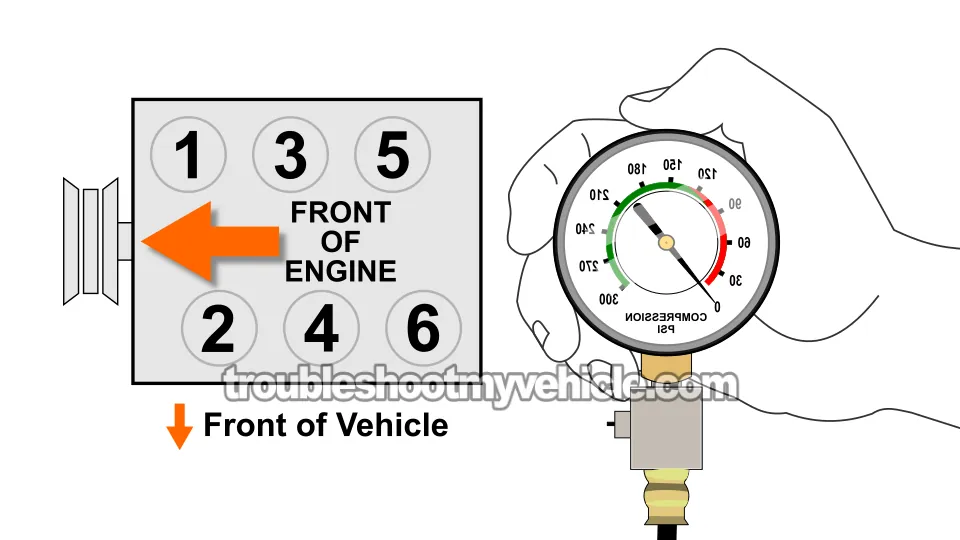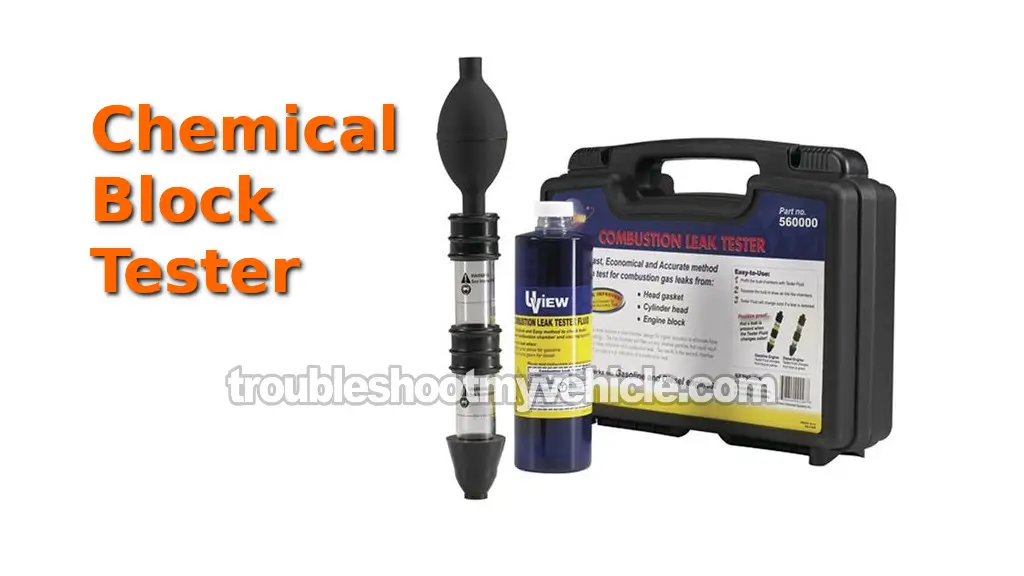TEST 3: Cylinder Compression Test

If you take a look at the photo at the beginning of this tutorial, you'll notice that the head gasket is burned in a spot right between two side-by-side cylinders.
This head gasket failure was causing 0 PSI compression in those two side-by-side cylinders.
The best way to diagnose this type of head gasket failure is with a compression test.
NOTE: You can find a more detailed explanation of the engine compression test and how to interpret its results here: How To Test Engine Compression (1991-2010 3.3L V6 Chrysler, Dodge, And Plymouth Minivans).
OK, these are the test steps:
- 1
Disconnect the ignition coil from its electrical connector. This is will disable the ignition system and is an important safety precaution.
- 2
Disconnect the fuel pump relay from its electrical connector.
- 3
Disconnect all spark plug wires (from their spark plugs).
- 4
Remove all of the spark plugs.
- 5
Thread in the compression tester by hand, on the first spark plug hole you're gonna' start with.
Do not use any tools to tighten the compression tester. Hand tightening the compression tester is more than enough to get the proper results. - 6
Have a helper crank the engine as you observe the compression tester.
- 7
When the tester's needle stops climbing, have your assistant stop cranking the engine.
- 8
Write down the reading and what cylinder it belongs to on a piece of paper (you can use the illustration above to help you identify the cylinder).
- 9
Remove the compression tester and repeat the above steps in the remaining cylinders.
OK, let's take a look at what your results mean:
CASE 1: All cylinder compression readings where normal. This is the correct test result and it confirms that both head gaskets are OK (not burned at a spot between two side-by-side cylinders).
If you still suspect a blown head gasket, go to: TEST 4: Using A Chemical Block Tester (Combustion Leak Tester).
CASE 2: Two side by side cylinders had 0 PSI compression. This engine compression reading confirms that the head gasket is burned thru' at the point between those two cylinders. You'll need to replace the head gasket.
TEST 4: Using A Chemical Block Tester (Combustion Leak Tester)

Unfortunately, a head gasket can fail and yet the engine starts and runs but overheats after a few minutes.
Usually, in these cases, the engine oil isn't mixed with coolant and the compression gases are not escaping into the cooling system.
This also means that the head gasket failure can not be pinpointed by the 3 previous tests. The test of last resort, is a block test with a combustion leak detector.
This is how the combustion leak detector test (block test) works:
- The combustion leak detector tester is filled with a blue liquid chemical (see photo above).
- The radiator cap is removed (you may have to drain some of the coolant in the radiator since this tool needs to ‘gulp’ some of the air inside the radiator).
- The engine is started.
- The tester is then placed on the open radiator neck.
- The rubber bellow is then squeezed to suck in the air up through the two fluid-filled chambers. As the air bubbles up through the fluid, it will cause a chemical reaction.
- If the blue chemical turns yellow (for gasoline engines), combustion gases are entering the radiator. This result confirms a head gasket failure, a cracked block, or a cracked cylinder head issue.
- If the blue chemical doesn't change color, you can conclude that you don't have a head gasket failure, a cracked block, or a cracked cylinder head issue.
You can shop for a block tester here:
Disclosure: As an Amazon Associate, I earn from qualifying purchases. If my tutorials help you, using these links is an easy way to support the site at no extra cost to you. Thank you!
More 3.3L V6 Chrysler, Dodge, And Plymouth Minivan Tutorials
You can find a complete list of tutorials in this index: 3.3L V6 Chrysler, Dodge, And Plymouth Minivan Index Of Articles.
- How To Test The MAP Sensor (2001-2004 3.3L V6 Chrysler And Dodge Mini-Van).
- How To Test The Alternator (2001-2007 3.3L Chrysler).
- How To Test Engine Compression (1991-2010 3.3L V6 Chrysler, Dodge, And Plymouth Minivan).
- How To Test The Coil Pack 3.3L, 3.8L Chrysler, Dodge, Plymouth (at: easyautodiagnostics.com).

If this info saved the day, buy me a beer!




